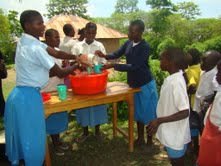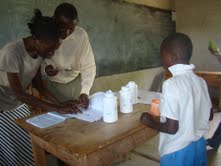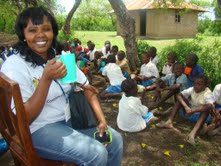By Dickens Wasonga.
The Kenya Medical Research Institute [KEMRI] in partnership with the America’s Center for Disease Control [CDC] has scaled up efforts to control the alarming prevalence rates of bilharzia along Kenya’s Lake Victoria riparian districts.
The renewed efforts targets to benefit over 400,000 primary school going children within the selected eight districts where the disease was found to be common.
Currently the team which includes scientists working with other relevant ministries are administering a drug that is able to control bilharzia which mostly affect people who are in constant contact with contaminated water.
A study carried out in the region revealed that most fishermen and children from schools near the lake were the hardest hit by the disease.
The program launched last year by the Kenya Medical Research Institute in collaboration with the America’s Centers for Disease Control will cover over 200 schools along the shores of Lake Victoria .
Kenya Medical Research Institute Principal Research Officer Pauline Mwinzi said that Sh 150 million will be used to finance the program in Nyanza Province in the next five years.
The researcher who was accompanied by KEMRI Research officer in the region, Elizabeth Matei and the assistant communication officer John Riaga were at Agok Primary School in Rarieda District to supervise the drug administration in the school.
Rarieda is amongst the eight districts in Nyanza where the exercise is ongoing. The others includes Bondo , Kisumu east and West , Kisumu municipality, Rachuonyo, .Homa -Bay and Nyakach districts.
According to the scientist ,between 10-100 percent of people living along Lake Victoria are affected with the bilharzia parasite thus the need to eradicate the scourge in the region.
“Bilharzia affects 7 million Kenyans in 62 Districts majority from Nyanza region and 12 million people are at risk of the infection,” she said.
A drug known as ,praziquantel, whose dosage is determined by weight and height was being given to the pupils at risk of infection by the parasite.
Although the disease has a low mortality rate, schistosomiasis can damage internal organs and, in children, impair growth and development adding that It is the second most socio-economic devastating parasitic disease after malaria which need more attention.
Since the program was launched late last year, at least two teachers from all the 225 primary schools identified in Nyanza province have been trained to benefit from the program.
“So far we have managed to train over 200 teachers from schools within this province to administer the drugs to pupils and are optimistic that we will soon complete the training so that many pupils across the Province benefit,” she added.
Community health workers who will help in the administration of the drugs to the community have also been trained.
“ We have covered eight districts in this Province among them Bondo, Rarieda, Homabay, Kisumu East, Kisumu West, Kisumu Municipality, Nyakach and Rachuonyo,” she added.
She said in Rarieda and Bondo Districts, 60 schools, 30 from each District will benefit from the program.
” Schools are targeted because our previous studies demonstrated a link between school proximity to the lake and the prevalence of the disease, suggesting that the lake is the primary source of schistosomiasis transmission in this region,” said Mwinzi.
The Scientist said prevalence levels can go up to 100% and school children are the most affected.
The disease as referred to as schistosomiasis is caused by worm parasites transmitted by snails.
Those whose activities force them to come into contact with water where infected snails live and where there may be transmission going on is likely to suffer from the disease.
Ends
the pupils being fed with porridge before the drug is given as required
a teacher administer the drug to one of the pupil at Agok primary school in Rarieda
the scientist enjoys a cup of porridge with the pupils at the school.




This is a very good project. Keep it up.